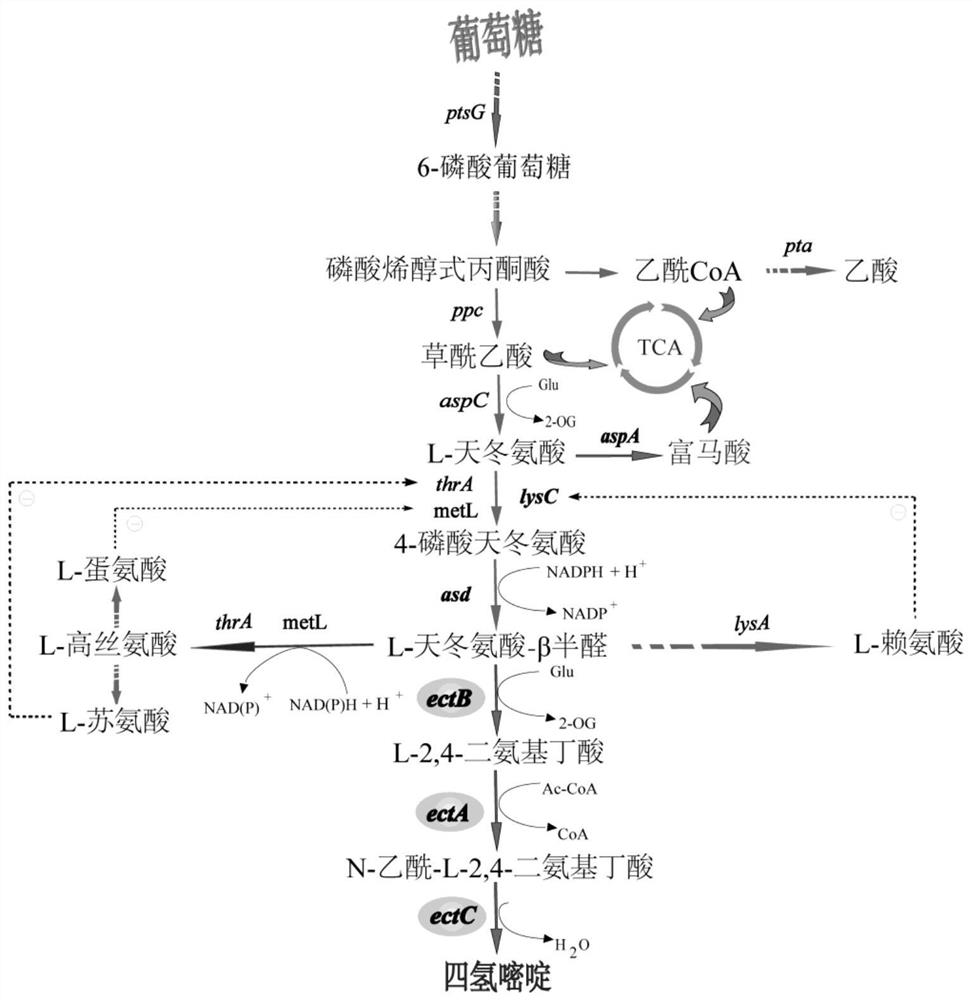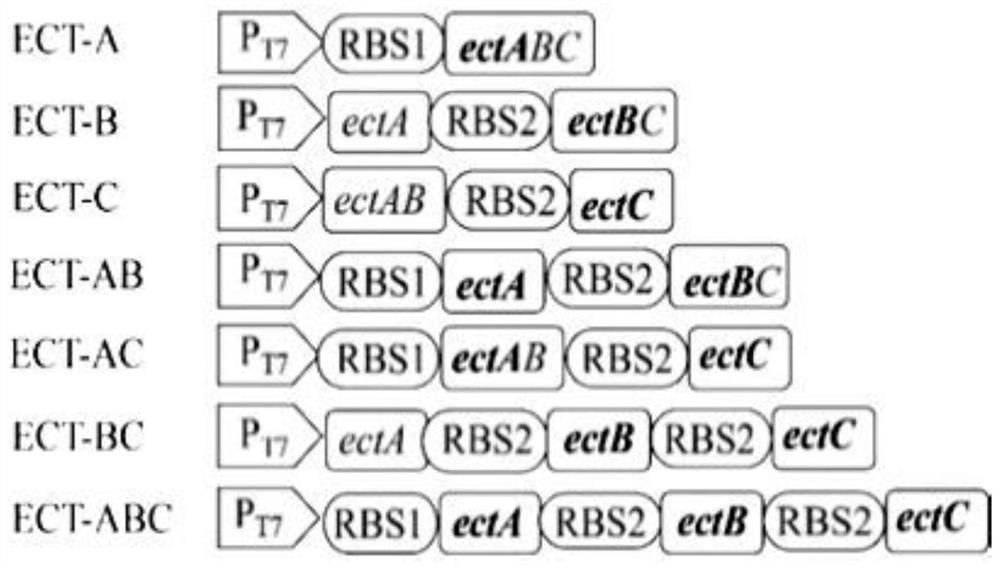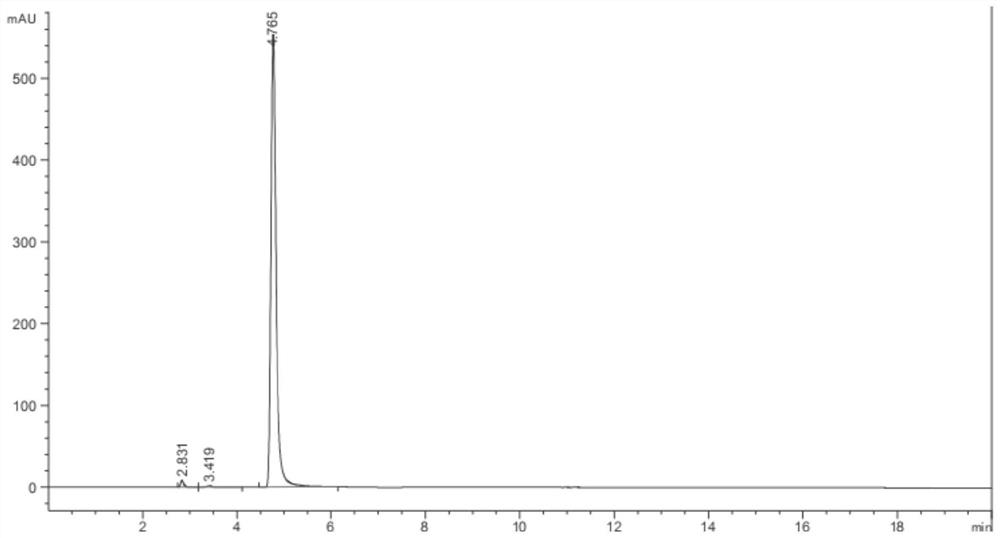Construction method of high-yield ectoine engineering strain and application thereof
A technology of tetrahydropyrimidine and engineering bacteria, applied in the field of bioengineering, can solve problems such as affecting the production of tetrahydropyrimidine, and achieve the effects of avoiding pressure and saving costs
- Summary
- Abstract
- Description
- Claims
- Application Information
AI Technical Summary
Problems solved by technology
Method used
Image
Examples
Embodiment 1
[0048] Example 1: Construction of recombinant plasmid pRSFDuet-1-ectABC
[0049] (1) Extract the genome of Halomonas elongata, and design primers ectABC-F / ectABC-R (ectABC-F: ggccggccgatatccaattgagatctgccgctacagcgaaccacgacaatgaac; ectABC-R: gcggtttctttaccagactcgagggtaccgttacagcggcttctggtcgtcggcttcg), using the genome elongation as the template Use primers to carry out PCR to amplify and obtain the target gene fragment ectABC (shown in SEQ ID NO.1) with the original RBS sequence;
[0050] (2) Extract plasmid pRSFDuet-1, whose nucleotide sequence is SEQ ID NO.7, and design primers pRSFDuet-1-F1 / pRSFDuet-1-R1 (pRSFDuet-1-F1: cggtaccctcgagtctggtaaagaaaccgctgctgcgaaatttgaac; pRSFDuet-1-R1: ggccggccgatatccaattgagatctgccatatgtatct ), using the plasmid pRSFDuet-1 as a template, performing PCR amplification to obtain the linearized vector pRSFDuet-1 at the expression cassette of the first T7 promoter;
[0051] (3) Ligate the fragments obtained in steps (1) and (2) with a one-step clon...
Embodiment 2
[0052] Embodiment 2: Construction of recombinant bacterial strain E / pR-ABC and shake flask horizontal culture
[0053] (1) Preparation of CaCl 2 Solution:
[0054] (2) Pick a single colony of E.coli BL21(DE3) from the LB plate, inoculate it in 5ml LB liquid medium, and cultivate it overnight at 37°C and 220rpm;
[0055] (3) Transfer the bacterial solution to a 250mL shake flask containing 50ml LB liquid medium at 2%, and cultivate it at 37°C and 220rpm until OD600=0.4-0.6;
[0056] (4) Place on ice for 15 minutes, then centrifuge at 4000 rpm, 4°C for 10 minutes to collect the bacteria;
[0057] (5) Resuspend the bacteria in CaCl after ice bath 2 Solution, after standing for 30min, centrifuge at 4000rpm, 4°C for 10min;
[0058] (6) Discard the supernatant and re-add 1-2mL CaCl 2 Solution, mix well, dispense 50-100μL per tube into 1.5ml sterilized centrifuge tubes, store at -80°C or perform transformation;
[0059] (7) The recombinant plasmid pR-ABC obtained in Example 1 w...
Embodiment 3
[0065] Embodiment 3: construct recombinant plasmid R-A, R-B and R-C
[0066] 设计引物EctA-F / EctA-R(EctA-F:gtataagaaggagatatacataatgaacgcaaccacagagccctttacaccc;EctA-R:ctctgtggttgcgttcattatgtatatctccttcttatacttaactaatatac),EctB-F / EctB-R(EctB-F:aaggaggaaaatatccacaggaggtcgcaatgca;EctB-R:gtggatattttcctccttcgtcccggctcagatctggtc),EctC-F / EctC- R (EctC-F: aaggaggaaaatatcgacatgatcgttcgcaatctcg; EctC-R: gtcgatattttcctcctttcagctaaaggcctgcttggtg), the recombinant vector pR-ABC was used as a template to carry out circularization PCR, and the genes ectA, ectB and ectC were subjected to RBS sequence replacement respectively to obtain a single-gene RBS sequence replacement recombinant vector R-A, R-B and R-C, wherein the RBS sequence of ectA is replaced by the RBS sequence behind the T7 promoter on the vector pRSFDuet-1 (as shown in 287~300bp of SEQID NO.7), named R-A; the RBS sequences of ectB and ectC are both Replaced with the nucleotide sequence shown in SEQ ID NO.11, the resulting recombinant...
PUM
 Login to View More
Login to View More Abstract
Description
Claims
Application Information
 Login to View More
Login to View More - R&D
- Intellectual Property
- Life Sciences
- Materials
- Tech Scout
- Unparalleled Data Quality
- Higher Quality Content
- 60% Fewer Hallucinations
Browse by: Latest US Patents, China's latest patents, Technical Efficacy Thesaurus, Application Domain, Technology Topic, Popular Technical Reports.
© 2025 PatSnap. All rights reserved.Legal|Privacy policy|Modern Slavery Act Transparency Statement|Sitemap|About US| Contact US: help@patsnap.com



